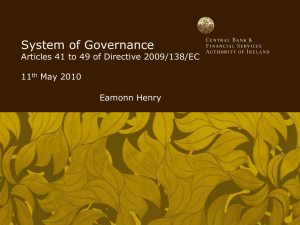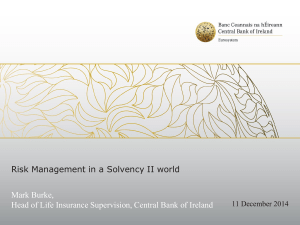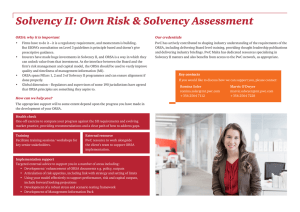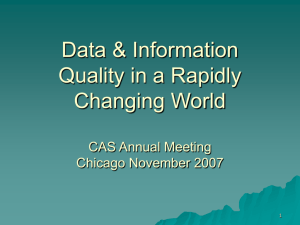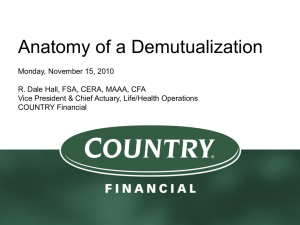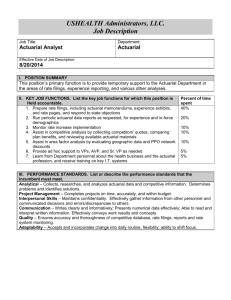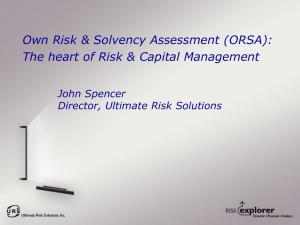File - Malta Actuarial Society
advertisement
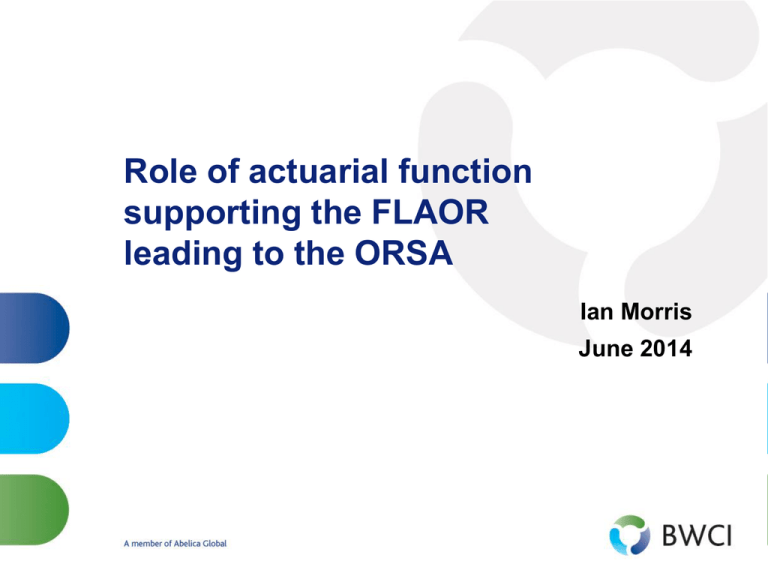
Role of actuarial function supporting the FLAOR leading to the ORSA Ian Morris June 2014 Contents • ORSA requirements • Insurance Rule 31 • The Forward Looking Assessment of Own Risks Introduction to BWCI • • • • • • Established in 1979 Independent Partnership 100 staff (in Guernsey and Jersey) 15 qualified actuaries Specialist insurance team Clients in a range of jurisdictions • Guernsey, Jersey, Malta, Gibraltar, UK, Mauritius etc 3 Own Risk and Solvency Assessment • Article 45 of Solvency II directive • Part of risk management system • Not a capital requirement Key Aims • Assess overall solvency needs • Specific risk profile • Approved risk tolerance limits • Business strategy • Continuous compliance with solvency requirements • How different from standard risk profile? Solvency Assessment • Processes in place proportional to nature, scale and complexity of entity • Properly identify and assess short and long term risks • Demonstrate methods used ORSA • Integral part of business strategy • Used for strategic decisions • Updated regularly and for significant change in risk profile • Results reported to regulator Role of Actuarial Function in ORSA • Contribute to effectiveness of risk modelling • Work highly dependent on nature and scale of entity • …but this is just the minimum requirement How can risk modelling be effective? • Integrate all aspects of risk assessment • Understand how the business sets risk appetite • Model should reflect approach to business • Not just doing projections ORSA for large entity • Likely to be based on detailed model • Possibly an internal model • Would require extensive work and documentation Actuarial challenges • Technical challenge to model a large (and potentially complex business) • Not easy to ensure model is robust • How to communicate results to Board in a way that ORSA is integral to business strategy? • Need to convince a regulator that model is appropriate ORSA for a small entity • How much work is needed? • Will resources be available? • What level of proportionality is appropriate? Actuarial challenges • Undertake enough work to be satisfied that the risk modelling is valid • Simplifications likely to be needed but whose judgement? • How will regulators judge proportionality? Insurance Rule 31 • Implementation of latest EIOPA Guidelines in Malta • • • • Governance FLAOR Submission of Information Pre-application of Internal Models • Effective 1 January 2014 Coverage • EIOPA requires entities covering 80% of market share to be included • In practice most entities likely to need to comply Forward Looking Assessment of Own Risks • Proportional • • Own risk management • Nature, scale and complexity Role of Board • Should steer process • Challenge results Process • Documentation needed includes • • • • Policy for assessment Record of each assessment Internal report Supervisory report Policy • Description of processes and procedures • Consideration of risk profile, risk tolerance • limits and solvency needs Information on • How and how often stress tests, sensitivity etc • Data quality • Frequency (with rationale) • Timing (and circumstances that would change this) Reporting • Appropriate evidence and documentation • Internal report (to all relevant staff) • Supervisory report to include • Qualitative and quantitative results • Methods and assumptions • Comparison of solvency needs, regulatory capital and own funds Specific guidance • Use standard basis or justify alternatives • Express quantitatively and qualitatively • • • Adequate range of stress and sensitivity tests Forward looking (medium or long term) Regulatory capital • Comply on continuous basis • Potential changes in risk • Impact of asset changes Technical Provisions • Seek advice from actuarial function • Continuous compliance with requirements on calculation of technical provisions • Identify risks from uncertainties relating to this calculation • Assess whether risk profile deviates from standard model Strategy • Take into account results and insights • Capital management • Business planning • Product development and design Role of actuarial function • If limited to minimum level in the guidance will this be enough to prepare for ORSA? • What will regulators expect? Wider view needed (in my opinion) • Look at elements required • Consider actuarial aspects • Direct issues impacting on technical provisions • Other issues which have potential impact for risk modelling Actuary should consider • Approach to risk management • Understood • Reasonable • Proportional • Nature • Scale • Complexity Documentation • Is this adequate? • Would actuarial view help? • What reports should actuarial function produce (or comment on)? Policy • Should be able to add value in many areas • • • • • Risk profile Risk tolerance Stress tests Sensitivity Data Reporting • Actuarial function should be able to bring rigor and technical expertise to reports • Value to board • Value to regulator Benefits of wider view • Actuarial function should have deeper understanding of risk and modelling • Sounder basis for advice • More comfort to regulator Problems with wider view approach • Will adequate resources be available to allow actuarial function this depth of involvement? • Do we have all the skills needed? • Communication challenge to • Establish resources • Provide response that shows value from involvement ?Questions?

